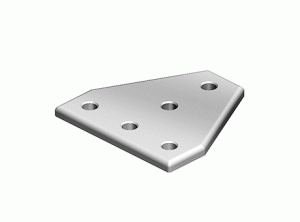
Connection plates offer a simple and convenient way to join aluminum profiles. Also known as profile connectors, they are commonly used in framework applications. If you regularly work with aluminum profiles, you may want to use connection plates to join them. For a better understanding of connection plates, keep reading.
Overview of Connection Plates
Connection plates are flat plate-like connectors that are designed to join two or more aluminum profiles. Aluminum profiles, of course, are made via extrusion. They are made by forcing aluminum through a die. The raw aluminum will then take the cross-section shape of the die.
There are different ways to join aluminum profiles. You can always weld or solder them, or you can use traditional adhesives. Alternatively, you can join the aluminum profiles with connection plates.
Benefits of connection plates include the following:
- Compatible with most types of T-slot aluminum profiles
- Easy to install
- Available in a variety of styles
- Won’t damage or degrade the aluminum profiles with which they are used
How Connection Plates Work
You might be wondering how connection plates work. While available in different styles and sizes, they all work in conjunction with fasteners to secure and hold the aluminum profiles together.
Connection plates essentially work as brackets. You can connect them to the sides of aluminum profiles using the appropriate fasteners, such as T-nuts, washers and bolts. Start by placing the T-nuts in the aluminum profiles. You can then position the connection plates over the aluminum profiles. Once in place, drive the bolts through the connection plates and into the T-nuts. This is just one way you can use connection plates.
Choosing Connection Plates
You should consider the style when choosing plates. All connection plates feature holes to accommodate threaded fasteners, but they are available in many different styles. Some styles have connection plates that feature a different shape than others. The number of holes may also vary depending on the style.
When choosing connection plates, you should consider the angle at which you intend to join the aluminum profiles. Different styles are designed for different angles. You’ll need to choose a style, as well as a size, that’s compatible with the desired connection angle.
In Conclusion
Connection plates are exactly what they sound like: plates that function as connectors. They are designed for use with aluminum profiles. Rather than welding or soldering the aluminum profiles together, you can use a set of connection plates. Just remember to choose the right connection plates.
